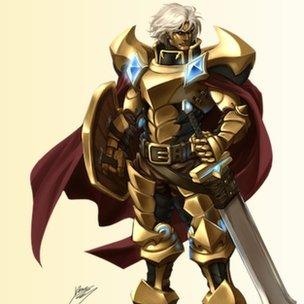How to use games to teach physics
- Published

Lessons have become structured around games with World of Classcraft
For some schoolchildren physics is a chore, for others a breeze. But for the pupils in Shawn Young's class, it is a game.
Mr Young, who teaches physics to 16-year-olds at a school in Quebec, Canada, has turned to video games in a bid to make the children in his class pay more attention. He had dubbed the system he has developed World of Classcraft to acknowledge its debt to online game World of Warcraft.
In Mr Young's class pupils are divided into teams of eight. Within that team, each pupil takes on the role of either a warrior, priest or mage (wizard). Each one of these roles has powers associated with it. Some are trivial, such as being able to open a window during class, but others are much more useful. For instance, powerful mages are granted the "Time Warp" ability which lets them take eight minutes longer to finish an exam.
"The low level powers are pretty goofy," Mr Young told the BBC, "but there's real incentives in the higher ones."
Power play
Pupils gain points to spend on powers by gathering experience points or XP. These are given for good behaviour in class, finishing assignments on time, doing well in exams and helping other members of their team to do their homework. The current rate is 1,000 XP for one power point, which buys one basic power.
"The whole game is based around them being in teams," he said. "They get rewards for any kind of collaboration."
But Classcraft is not just about rewards. There are also penalties for pupils who mess about or fail to complete assignments.
When that happens, the character representing that player loses some of their hit points. In games, these are a measure of a character's toughness. Warriors have lots of hit points and can choose to soak up the hit point penalties suffered by team members. Priests can heal hit points to get them back to full health.
If a pupil's character loses all their hit points and "dies" they suffer real world penalties, This could be less time on an exam or a Saturday morning detention.
The stats for each pupil and the character are tracked by Mr Young who has written a game engine to log all the daily changes in XP, hit points and power uses. That engine also generates random events that effect everyone in the class. Some are helpful, such as a blessing that heals hit points, others bad, such as a curse that reduces the same stat.
Lessons learned
"This is the first time where I've seen the actual structure of an massively, multi-player game integrated so actively into teaching," said Dr Ladan Cockshut, who studied WoW gamers and their culture for her PhD.
Dr Cockshut said online games were increasingly being used by teachers because they were great sandboxes for many good educational habits such as individual advancement, team working, research and debate.
"It would seem a good way to give students a chance to link their love of a game to a love of learning," she said. "which can't hurt from a teaching point of view."
Mr Young said despite the complexity of the game, most of the children he teaches have taken to it well - even the girls, despite the fact that video game players tended to be boys.
"The girls are just as into it as the boys," he said. "They are into it because there are real-life incentives for being involved."

Classcraft borrows some of the mechanics on an online fantasy game
But does it work? Does it turn inattentive students into eager scholars?
"It's hard to tell if there is a straight correlation between game and grades," he said. "On the other hand there's been a real observable gain in motivation."
That gain has been most stark among a group of students who, before Classcraft was introduced, were not working hard in class.
"They've started working like crazy because they want experience points," said Mr Young. Classcraft has been so successful that others teachers at Mr Young's school are now handing out XP for good performances.
Ollie Bray, a deputy head and also a consultant on technology in teaching, said World of Classcraft was just one example of the growing gamification of education and teaching.
A similar system was devised by US academic Lee Sheldon to teach his students how to make video games, he said, but World of Classcraft was the first to apply it to secondary school children.
Mr Bray's experiences suggested that teaching via technology had benefits because children saw the tasks they did on computers as non-competitive and computers as neutral when it came to marking their work.
Using games to teach or structuring lessons to make them more like games had been seen to work, particularly with kids that were hard to engage in other ways.
However, he said, using games required work to keep the approach fresh.
"If we are just doing the same things time and time again the children, and teachers, will get bored," he said. "It's not a magic bullet, just something else that should be in a teacher's toolbox."
- Published8 November 2012
- Published14 September 2012